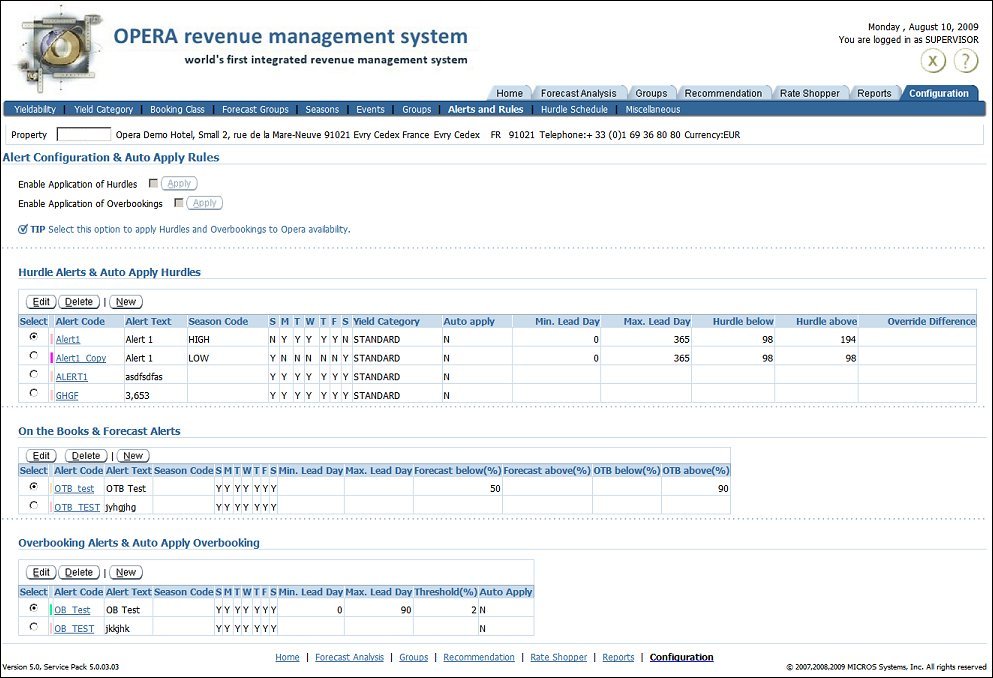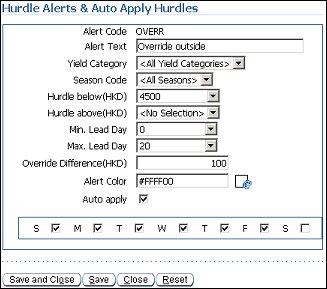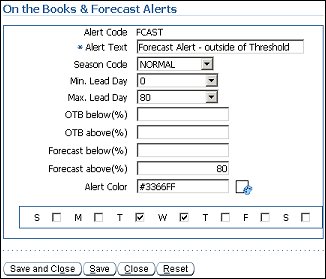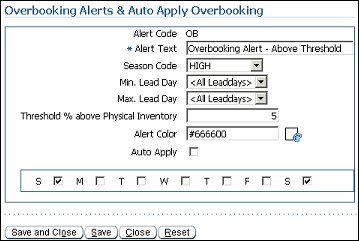
Configuration Tab Alerts and Rules
Configure alerts and rules for notification when hurdles are above or below specified numbers, forecast numbers are above or below specified thresholds, on the books percentages are above or below thresholds, or overbooking numbers have reached certain percentages. To help identify alerts and rules, colors can be applied to each. When the system generates hurdles, forecast figures, and oversell numbers that meet the configured alert conditions, Alerts are displayed on the Home Tab and the Recommendation Tab (Hurdle Recommendation and Overbooking Recommendation screens).
Note: Whenever an existing Alert or Alert Rule is modified or deleted from the Alerts and Rules Configuration Tab, all of the Alerts that were triggered in the past by the modified or deleted Alert's conditions will be removed from the database. And the next time that the ORMS Optimizer runs, all of the currently configured and updated Alerts and Rules on this Dashboard will be considered for the generation of new Alerts.

Enable Application of Hurdles. Selecting this check box and clicking the Apply button enables Hurdles to be applied to the OPERA availability. Leaving this box unchecked means that no hurdles will be applied in OPERA at all. By default, the Enable Application of Hurdles check box is not selected, but checking this function will automatically activate all ORMS hurdles in OPERA, even if some already exist.
In cases where another RMS system exists in OPERA along with ORMS, this check box will not be selected by default and is disabled. To enable this functionality, you must switch off the other RMS system. Then, select the Enable Application of Hurdles check box and the Apply button to activate all hurdles in OPERA.
Note: When this check box is selected, you have the opportunity to modify and approve/apply changes to OPERA for hurdle specifications from the Recommendation Tab.
Enable Application of Overbookings. Available when the Rooms Management>Overbooking application function is set to Y in PMS for the property, selecting this check box and clicking the Apply button enables Overbookings to be applied to the OPERA availability. Leaving this box unchecked means that no overbookings will be applied in OPERA at all. By default, the Enable Application of Overbookings check box is not selected, but checking this function will automatically activate all ORMS overbookings in OPERA, even if some already exist.
In cases where another RMS system exists in OPERA along with ORMS, this check box will not be selected by default and is disabled. To enable this functionality, you must switch off the other RMS system. Then, select the Enable Application of Overbookings check box and the Apply button to activate all overbookings in OPERA.
Note: When this check box is selected, you have the opportunity to modify and approve/apply changes to OPERA for overbooking specifications from the Recommendation Tab.
The grid displays configured hurdle alerts.
Select. Select this radio button to activate the alert.
Alert Color. Color configured for the alert.
Alert Code. Code assigned that is used to indicate the alert. This code is user definable and may contain numbers or characters, or a combination of both.
Alert Text. Description about what the alert represents and circumstances when it will be displayed. The text is user definable.
Season Code. The name of the season for which the alerts will be applied (set up when New or Edit was selected). The season code itself was defined in Configuration Tab Seasons.
Days of Week. Beginning with S (Sunday), identifies the seven days of the week where alerts will be applied: Y = Alert and N = No alert (set up when New or Edit was selected).
Yield Category. Yield management category or categories this hurdle will be generated for.
Auto Apply. Displays a Y if the hurdle will automatically be activated in OPERA or will display a N if the hurdle will have to be manually reviewed and approved before being applied to OPERA.
Min. Lead Day. Minimum number of days (0-365) from the arrival date the hurdle alert will display, where 0 is the arrival date.
Max Lead Day. Maximum number of days (365-0) from the arrival date the hurdle alert will display, where 0 is the arrival date.
Hurdle Below. Number configured so that an alert will display when the calculated hurdle value falls below this amount.
Hurdle Above. Number configured so that an alert will display when the calculated hurdle value is above this amount.
Override Difference. Value that has been set to override the auto generated hurdle amount when it is less than or greater by this flat amount.

Alert Code. Code assigned and used to indicate the alert. This code is user definable and may contain numbers or characters, or a combination of both.
Alert Text. Description about what the alert represents and circumstances when it will be displayed. The text is user definable.
Yield Category. Yield management category or categories this hurdle will be generated for.
Season Code. Select the name of the season for which you want the alerts to apply. You may select All Seasons or a specific season. The season code itself was defined in Configuration Tab Seasons.
Hurdle Below (Currency). Number configured so that an alert will display when the calculated hurdle value falls below this amount.
Hurdle Above (Currency). Number configured so that an alert will display when the calculated hurdle value is above this amount.
Min. Lead Day. Minimum number of days (0-365) from the arrival date the hurdle alert will display, where 0 is the arrival date.
Max Lead Day. Maximum number of days (365-0) from the arrival date the hurdle alert will display, where 0 is the arrival date.
Override Difference(Currency). Display alert when the value that has been set to override the auto generated hurdle amount when it is less than or greater by this flat amount.
Alert Color. Select the ![]() to choose a color to represent the alert when it is displayed. The code in the field represents the color selected in HTML format.
to choose a color to represent the alert when it is displayed. The code in the field represents the color selected in HTML format.
Auto Apply. Select to have the hurdle automatically approved and activated in OPERA. Or, unselect it so the hurdle will have to be manually reviewed and approved before it is applied. The approval and activation can also be done on the Recommendation Tab. Leaving this check box unselected will override the general setting of Enable Application of Hurdles and Overbooking on the main screen.
Note: If the Auto Apply hurdle check box is not selected and ORMS generates a hurdle that is either below the value defined in the ‘Hurdle Below’ field or else above the value defined in the 'Hurdle Above' field, ORMS will update the OPERA hurdle with the defined value in those fields.
For example:
An alert is configured for NORMAL season and Yield Category STANDARD with the 'Hurdle Above' value = 150.00. The Auto Apply hurdle check box is not flagged.
- If ORMS calculates a hurdle amount for any day in NORMAL season, for Yield Category STANDARD that is above 150.00, the hurdle applied to OPERA will be 150.00 for all Room Types that belong to the STANDARD Yield Category.
- The hurdle with the amount above 150.00 will appear in the Recommendation screen as not approved and the user can decide whether to override it or approve it as-is.
Days of Week. Select the check boxes for the days of the week (Sunday through Saturday) when you want alerts applied. By default, all days of the week check boxes are selected - deselect the days you do not want alerts applied.
The grid displays configured On the Books and Forecast alerts:
Select. Select this radio button to activate the alert.
Alert Color. Color configured for the alert.
Alert Code. Code assigned and used to indicate the alert. This code is user definable and may contain numbers or characters, or a combination of both.
Alert Text. Description about what the alert represents and circumstances when it will be displayed. The text is user definable.
Season Code. The name of the season for which the alerts will be applied (set up when New or Edit was selected). The season code itself was defined in Configuration Tab Seasons.
Days of Week. Beginning with S (Sunday), identifies the seven days of the week where alerts will be applied: Y = Alert and N = No alert (set up when New or Edit was selected).
Min. Lead Day. Minimum number of days (0-365) from the arrival date the forecast alert will display, where 0 is the arrival date.
Max Lead Day. Maximum number of days (365-0) from the arrival date the forecast alert will display, where 0 is the arrival date.
On the books below (%). Percentage set that an alert will be displayed if the 'on the books' rooms reserved are below the total physical rooms, which may or may not include Out of Order rooms or Comp/House rooms, depending on if these check boxes are selected on the Home Tab.
On the books above (%). Percentage set that an alert will be displayed if the 'on the books' rooms reserved are above the total physical rooms, which may or may not include Out of Order rooms or Comp/House rooms, depending on if these check boxes are selected on the Home Tab.
Forecast Below(%). Percentage set that an alert will be displayed if the forecasted occupancy percentage for a specific date is below this amount for the house level.
Forecast Above(%). Percentage set that an alert will be displayed if the forecasted occupancy percentage for a specific date is above this amount for the house level.
You can create alerts that are only OTB or only Forecast alerts, or a logical combination of both, using this screen. As an example of a combination of OTB and Forecast alerts, is if you have 60 days remaining in your timeframe and you want to view the Forecast 95% above your threshold and the OTB below 25% until one day before the arrival date, you could enter the following. When adding or editing these alerts, if the system finds that your thresholds are not logical when you select Save, you will receive an error message.

Alert Code. Code assigned and used to indicate the alert. This code is user definable and may contain numbers or characters, or a combination of both.
Alert Text. Description about what the alert represents and circumstances when it will be displayed. The text is user definable.
Season Code. Select the name of the season for which you want the alerts to apply. You may select All Seasons or a specific season. The season code itself was defined in Configuration Tab Seasons.
Min. Lead Day. Minimum number of days (0-365) from the arrival date the forecast alert will display if the forecasted occupancy generated meets the set conditions, where 0 is the arrival date.
Max Lead Day. Maximum number of days (365-0) from the arrival date the forecast alert will display if the forecasted occupancy generated meets the set conditions, where 0 is the arrival date.
On the books below (%). Enter the Percentage set that an alert will be displayed if the 'on the books' rooms reserved are below the total physical rooms, which may or may not include Out of Order rooms or Comp/House rooms, depending on if these check boxes are selected on the Home Tab.
On the books above (%). Enter the Percentage set that an alert will be displayed if the 'on the books' rooms reserved are above the total physical rooms, which may or may not include Out of Order rooms or Comp/House rooms, depending on if these check boxes are selected on the Home Tab.
Forecast Below(%). Enter the Percentage that an alert will be displayed if the forecasted occupancy percentage for a specific date is below this amount for the house level.
Forecast Above(%). Enter the Percentage set that an alert will be displayed if the forecasted occupancy percentage for a specific date is above this amount for the house level.
Alert Color. Select the ![]() to choose a color to represent the alert when it is displayed. The code in the field represents the color selected in HTML format.
to choose a color to represent the alert when it is displayed. The code in the field represents the color selected in HTML format.
Days of Week. Select the check boxes for the days of the week (Sunday through Saturday) when you want alerts applied. By default, all days of the week check boxes are selected - deselect the days you do not want alerts applied.
Available when the Rooms Management>Overbooking application function is set to Y in PMS for the Property, the grid displays configured Overbooking and Auto Apply Overbooking alerts.
Select. Select this radio button to activate the alert.
Alert Color. Color configured for the alert.
Alert Code. Code assigned and used to indicate the alert. This code is user definable and may contain numbers or characters, or a combination of both.
Alert Text. Description about what the alert represents and circumstances when it will be displayed. The text is user definable.
Season Code. The name of the season for which the alerts will be applied (set up when New or Edit was selected). The season code itself was defined in Configuration Tab Seasons.
Days of Week. Beginning with S (Sunday), identifies the seven days of the week where alerts will be applied: Y = Alert and N = No alert (set up when New or Edit was selected).
Min. Lead Day. Minimum number of days (0-365) from the arrival date the overbooking alert will display if the forecasted overbooking meets the set conditions, where 0 is the arrival date.
Max. Lead Day. Maximum number of days (365-0) from the arrival date the overbooking alert will display if the forecasted overbooking meets the set conditions, where 0 is the arrival date.
Auto Apply. Displays a Y if the oversell limit will automatically be inserted or will display a N if the oversell limit will have to be manually reviewed and approved before being applied.
Threshold % Above Physical Inventory. Percentage set that when the Oversell Limit for the house reaches this percentage, an alert will be displayed.

Alert Code. Code assigned and used to indicate the alert. This code is user definable and may contain numbers or characters, or a combination of both.
Alert Text. Description about what the alert represents and circumstances when it will be displayed. The text is user definable.
Season Code. Select the name of the season for which you want the alerts to apply. You may select All Seasons or a specific season. The season code itself was defined in Configuration Tab Seasons.
Min. Lead Day. Enter the minimum number of days (0-365) from the arrival date the overbooking alert will display if the forecasted overbooking meets the set conditions, where 0 is the arrival date.
Max. Lead Day. Enter the maximum number of days (365-0) from the arrival date the overbooking alert will display if the forecasted overbooking meets the set conditions, where 0 is the arrival date.
Threshold % Above Physical Inventory. Enter the percentage that when the Oversell Limit for the house reaches this percentage, an alert will be displayed.
Alert Color. Select the ![]() to choose a color to represent the alert when it is displayed. The code in the field represents the color selected in HTML format.
to choose a color to represent the alert when it is displayed. The code in the field represents the color selected in HTML format.
Auto Apply. Select to have the oversell limit automatically approved and activated in OPERA. Or, unselect the check box so the oversell limit will have to be manually reviewed and approved before being applied. The approval and activation can also be done on the Recommendation Tab. Leaving this check box unselected will override the general setting of Enable Application of Hurdles and Overbooking on the main screen.
Days of Week. Select the check boxes for the days of the week (Sunday through Saturday) when you want alerts applied. By default, all days of the week check boxes are selected - deselect the days you do not want alerts applied.
See Also
|
|
|